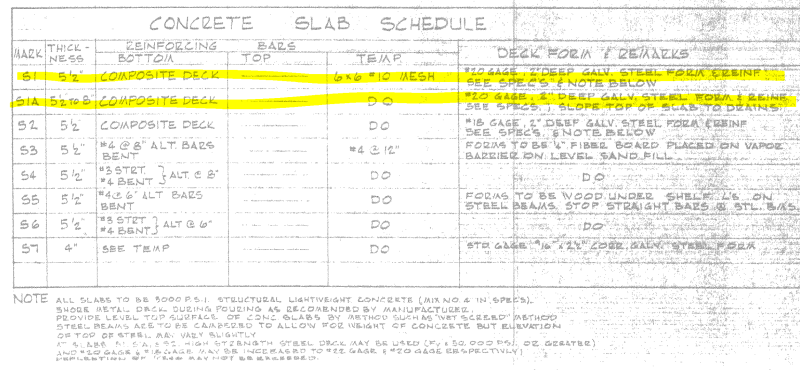I am in the process of analyzing an existing composite deck building from 1973. In the plans, it is called out to have a design roof live load of 30psf and doesn't say anything about snow load. This site is in the UP right on Lake Superior, so the ground snow load is 70psf and the balance snow load is closer to 50psf, so I am a little concerned for how the decking is going to perform. The decking also spans 10', which seems far without actually crunching any numbers. I do have good information for what the decking is, I just don't have an easy way to calculate its capacity.
For steel joists, there is a 75 year catalog that has all of the historical joist information and span tables. However, I cannot seem to find something equivalent for the steel decking. If it helps, in one of our old projects, I was able to find this page from an old decking catalog, but it is too new for my building. The part that is highlighted is not what I have on my building. Can someone point my in a direction to find the right catalog that would have been current in 1973?

I'm guessing that I'm going to have to hand calc the deck's capacity because the span isn't even on the table below. Seeing that my building is only a few years older than the catalog's date, I'm anticipating that the design assumptions/material strengths that are made on page 4 above were the standard for my building. Can someone confirm if this is a reasonable assumption? If not, what should be considered instead?
Thanks for the help!
For steel joists, there is a 75 year catalog that has all of the historical joist information and span tables. However, I cannot seem to find something equivalent for the steel decking. If it helps, in one of our old projects, I was able to find this page from an old decking catalog, but it is too new for my building. The part that is highlighted is not what I have on my building. Can someone point my in a direction to find the right catalog that would have been current in 1973?

I'm guessing that I'm going to have to hand calc the deck's capacity because the span isn't even on the table below. Seeing that my building is only a few years older than the catalog's date, I'm anticipating that the design assumptions/material strengths that are made on page 4 above were the standard for my building. Can someone confirm if this is a reasonable assumption? If not, what should be considered instead?
Thanks for the help!

